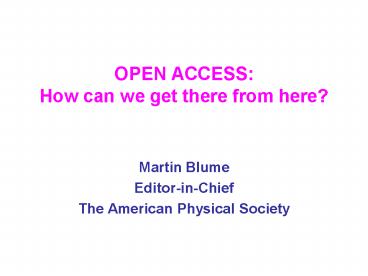OPEN ACCESS: How can we get there from here - PowerPoint PPT Presentation
1 / 13
Title:
OPEN ACCESS: How can we get there from here
Description:
'Free-to-Read' - continue subscriptions, but allow anyone - authors, CERN, ... Stopping a subscription, on the other hand, leads to a loss of access. ... – PowerPoint PPT presentation
Number of Views:42
Avg rating:3.0/5.0
Title: OPEN ACCESS: How can we get there from here
1
OPEN ACCESS How can we get there from here?
- Martin Blume
- Editor-in-Chief
- The American Physical Society
2
- There are many definitions of OA.
- By most of these the APS journals are OA.
- For this discussion we will consider OA as full
availability without barriers on the publishers
web site. - APS considers this a desirable goal.
- But there are significant costs to be recovered -
how can this be managed? And how can we get there
and stay there?
3
- APS has two OA journals Physical Review Special
Topics - Accelerators and Beams ( since 1998 -
supported by sponsorship) and PRST - Physics
Education Research ( since 2005 - supported by
author or institutional charges). Neither fully
recovers its costs. - Both are small journals, so losses are easily
covered by revenue from our larger journals (i.e.
APS is also a sponsor).
4
How can we convert our large journals to OA from
subscriptions?
- Three worries how to stay solvent while
- Transitioning.
- Sustaining.
- Reversing (if the above fail).
5
The role of CERN
- CERN wanted to promote OA for particle physics
articles. APSs PRL and PRD were important
journals. - At a meeting in Geneva in December 2005 a task
force was organized to pursue this goal. - We examined closely the requirements for us to
make PRD OA - 3.5 million (for 2400 articles)
excluding print! Splitting PRD would halve the
cost, but would delay the start by two years.
6
- The risk was enormous - loss of solid
subscription revenue, reliance on continued
sponsorship by CERN and others, and a need for
increases in sponsor fees to cover increases in
submissions. The sustainability question caused
us to examine reversibility, with considerable
concern. - We concluded that the three worries were
sufficiently great that we would not risk an
immediate transition to OA. - But we still wanted to try to find a route.
7
We concluded..
- Free-to-Read - continue subscriptions, but
allow anyone - authors, CERN, funding agencies,
institutions, grandparents, lovers, etc. - to pay
to make any articles on our site available for
reading by all. - Initial cost 975 for Phys Rev 1300 for PRL.
(About 1/2 the full cost per article.) - Use increased revenue to lower subscription
costs, especially to smaller institutions, and to
offset risk. As the number of FTR articles
increases and subs are lost we would increase
charges. Eventually we could transition to full
OA.
8
- Still - worries about sustainability. There is no
loss if sponsorship is discontinued - access is
still there. Stopping a subscription, on the
other hand, leads to a loss of access. Both have
problems, but there is more leverage. And moral
suasion is not a business model. - But publishing is not a theoretical science,
rather its an experimental art. There is no
substitute for doing the experiment, and for
watching closely what others do.
9
The following slides are for responses to
questions
10
NumbersAssuming author charges
- Annual budget for journals 30 Million.
- 16,000 articles published 1900 per article.
- At 50 honoring rate 3800/article.
- Needs dealing with 16,000 authors or their
institutions, requiring a larger development
staff than current subscription staff! (even
larger if in addition institutional support is
sought).
11
ConclusionsAs presented at CERN, Dec. 2005
- We will not for the present embrace open access
beyond what we already do. - We will continue to make our journals as widely
available as possible by broadening consortia and
continuing tiered pricing for subscriptions.
12
13































